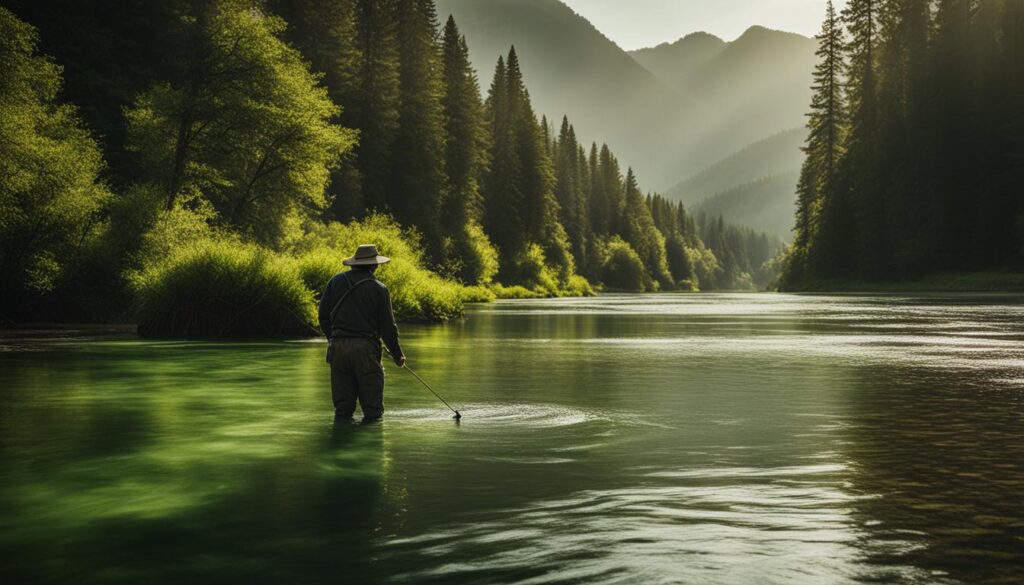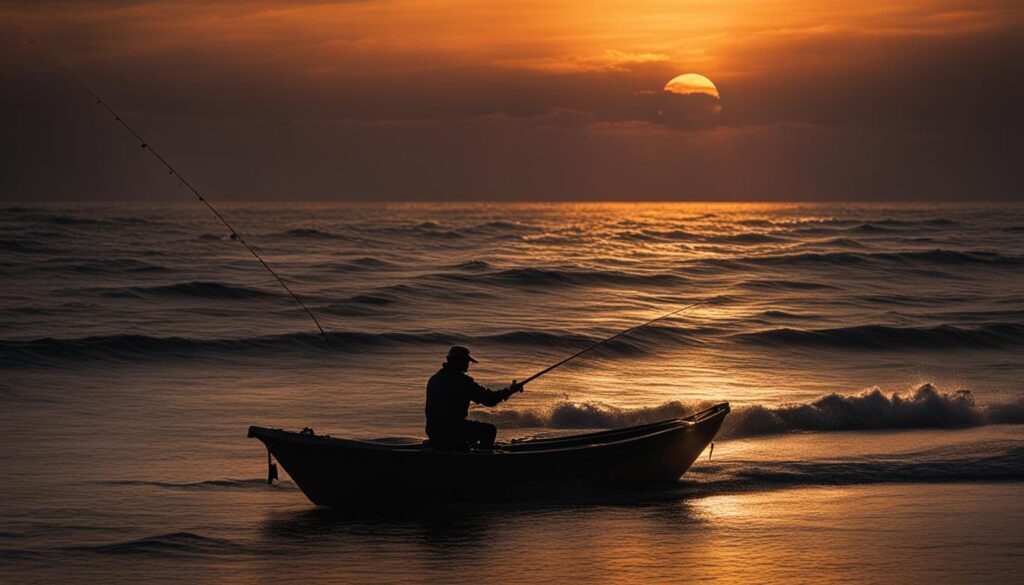We may earn money or products from the companies mentioned in this post.
Fishing is a popular recreational activity enjoyed by millions of people worldwide. However, overfishing has become a significant threat to fish populations, leading to a decline in marine diversity and jeopardizing the long-term ecological health of our oceans and rivers. Catch and release practices are integral to promoting sustainable fishing practices, enabling anglers to enjoy the sport while preserving fish populations for future generations.
Responsible fishing methods and ethical fishing techniques are necessary to ensure the well-being of the fish and minimize harm to their habitats. By utilizing catch and release practices, fishermen can play an active role in maintaining healthy fish stocks and promoting sustainable fishing practices.
Key Takeaways:
- Catch and release practices are important in promoting sustainable fishing practices
- Responsible fishing methods and ethical fishing techniques are necessary to minimize harm to fish habitats
- Catch and release practices can help maintain healthy fish stocks, benefiting future generations
- By using catch and release practices, anglers can actively contribute to preserving fish populations and promoting environmentally friendly fishing practices
- Adopting responsible fishing methods and utilizing catch and release practices is a collective responsibility to protect and promote fish sustainability
Understanding Catch and Release Practices
Catch and release practices have become increasingly popular in recent years as a way to promote fish conservation and preserve fish populations. In this section, we’ll explore the strategies and techniques involved in these practices and highlight the benefits of adopting them.
The Importance of Fish Conservation
Before delving into catch and release practices, it’s important to understand why fish conservation is so crucial. Fish play a vital role in our aquatic ecosystems, serving as a food source for countless other species and helping to maintain a delicate balance in the underwater world. However, overfishing and habitat destruction have put many fish populations at risk, threatening not only the survival of individual species but also the health of our oceans, rivers, and lakes.
Preserving fish populations is therefore an essential task for responsible anglers. By following catch and release practices, we can help maintain healthy fish populations and ensure that future generations can enjoy the thrill of fishing in our waterways.
Catch and Release Strategies
So how does catch and release work? The basic idea is to release a fish back into the water unharmed after catching it, rather than keeping it for consumption. While this may seem simple enough, there are a number of strategies and techniques involved in ensuring that the fish survives and thrives after being caught.
First and foremost, it’s important to use the right gear for the job. This includes using the right type and size of hook, as well as choosing the right type of fishing line. Barbless hooks can be particularly helpful in reducing harm to the fish, as they are easier to remove and cause less damage to the fish’s mouth.
Another key aspect of catch and release is minimizing the amount of time the fish spends out of the water. This means handling the fish as little as possible and returning it to the water quickly after removing the hook. Using a landing net can be helpful in this regard, as it can help prevent unnecessary handling and ensure a smooth release back into the water.
The Benefits of Catch and Release Practices
So why bother with catch and release practices? There are actually a number of benefits to adopting these techniques, both for individual anglers and for the wider environment.
For one thing, catch and release can actually improve the quality of fishing in a given area. By avoiding overfishing and preserving fish populations, anglers can help ensure that there are plenty of fish to catch in the future. In addition, catch and release practices can contribute to overall environmental health by promoting sustainable fishing and reducing the impact of human activity on our waterways.
Preserving Fish Populations
Ultimately, the goal of catch and release practices is to preserve fish populations for the long-term. By adopting responsible fishing practices and using the right techniques, anglers can play an important role in ensuring that fish continue to thrive in our waters. Whether you’re an experienced angler or just starting out, it’s important to keep these techniques in mind and do your part to protect the health and well-being of our aquatic ecosystems.
Ethical Angling Methods for Responsible Catch and Release
Adopting ethical fishing techniques and responsible fishing methods are crucial in ensuring successful catch and release. Engaging in practices that prioritize the welfare of the fish helps preserve their populations for future generations.
One of the most important ethical angling methods is the use of barbless hooks. These hooks make it easier to remove them from the fish’s mouth, minimizing the chances of injuring the fish. Additionally, it reduces the handling time, which is another critical factor in ensuring the fish’s survival.
Another approach that anglers can adopt is minimizing fish handling. The more time the fish spend out of the water, the less likely it is to survive once released. Therefore, it is essential to handle the fish as little as possible. Tools like fish grips can help anglers get a good grip on the fish without causing any harm.
Practicing proper fish release is also critical in ensuring catch and release success. When releasing a fish, hold it gently by the tail and move it back and forth to let water run through its gills. This process helps the fish regain its strength and ensures a higher chance of survival.
Lastly, it is essential to follow responsible fishing methods such as adhering to catch limits, releasing undersized fish, and avoiding fishing in spawning areas. By following these standards, anglers can contribute to the conservation of fish populations and promote sustainable fishing practices.
Tools and Equipment for Effective Catch and Release
Catch and release practices are an essential aspect of environmentally friendly fishing. Using the right tools and equipment can help minimize harm to fish while increasing their chances of survival. Here are some recommended tools and equipment for effective catch and release:
| Tool/Equipment | Description |
|---|---|
| Landing Net | A landing net with a soft mesh material can help support the fish’s weight and prevent damage to their gills and scales. A rubberized mesh also helps reduce tangling and is easier to handle than nylon. |
| Dehooking Tool | Using a dehooking tool can help reduce injury and stress on the fish. Tools like pliers or hemostats make the process safer and faster while minimizing the contact between the angler’s hands and fish. |
| Barbless Hooks | Barbless hooks enable easy hook removal without requiring excessive force, reducing the risk of injuring fish. If using barbed hooks, flatten the barbs or pinch them down to make them easier to remove. |
| Measuring Tape/Ruler | When measuring fish, use a measuring tape or ruler to get an accurate measurement quickly and efficiently. Try to avoid touching the fish’s gills or eyes when doing so. |
It is also essential to ensure that all equipment is clean and well-maintained to reduce the risk of contamination or injury to the fish. Taking these measures can help anglers promote sustainable fishing practices and protect our aquatic ecosystems for years to come.
Tips for Catch and Release Success
Practicing catch and release techniques is an essential part of ethical and sustainable fishing. Here are some tips to help you promote fish sustainability and protect fish stocks:
- Choose the right fishing equipment: Select equipment that minimizes harm to the fish, such as barbless hooks and landing nets. Avoid using treble hooks, which can cause significant damage to the fish.
- Use proper fish handling techniques: Handle the fish as little as possible and avoid touching their gills. Use wet hands or gloves to minimize damage to their skin. If you need to measure or weigh the fish, do so quickly and return it to the water as soon as possible.
- Use appropriate release techniques: When releasing the fish, hold it gently and upright in the water, facing the current. Allow it to swim away on its own, without tossing or dropping it in the water.
- Consider using circle hooks: Circle hooks are designed to hook the fish in the corner of the mouth, reducing the risk of injury. They also improve the chances of hooking the fish securely, making it easier to release them without causing harm.
- Choose the right fishing spots: Look for areas with healthy fish populations and avoid fishing in areas where fish are spawning or nesting. If you catch a large fish, consider releasing it, as larger fish typically contribute more to the overall fish population.
- Respect size and bag limits: Follow local regulations on size and bag limits to prevent overfishing and promote fish sustainability. If you catch a fish that is too small, gently release it so it can continue to grow and reproduce.
By following these tips, you can help promote sustainable fishing and protect fish stocks for future generations.
Beyond Catch and Release: Supporting Fish Conservation Efforts
As responsible anglers, it is our duty to not only practice catch and release techniques but also go beyond that to support fish conservation efforts. There are many strategies that we can adopt to promote fish sustainability and protect our aquatic ecosystems.
Participate in Fish Tagging Programs
Fish tagging programs are a valuable tool for scientists to monitor the movements and behavior of fish populations. As anglers, we can contribute to these programs by reporting tagged fish that we catch. This data can provide crucial insights into the migratory patterns and habitat preferences of various fish species, helping scientists make informed conservation decisions.
Get Involved in Habitat Restoration Projects
A healthy habitat is essential for the survival and growth of fish populations. By participating in habitat restoration projects, such as planting vegetation along riverbanks or removing invasive species, we can help create a more suitable environment for fish to thrive. This not only benefits the fish but also provides us with better fishing opportunities in the long run.
Advocate for Sustainable Fishing Regulations
As anglers, we have a unique perspective on the importance of sustainable fishing practices. By advocating for sustainable fishing regulations, we can help ensure that fish populations are managed responsibly and that future generations can continue to enjoy the sport of fishing. This may involve attending public meetings or writing to local government officials to express our concerns.
Promote Fish Sustainability
Finally, we can all make a difference by spreading awareness about the importance of fish conservation. By sharing our knowledge and promoting fish sustainability, we can inspire others to adopt responsible fishing practices and support conservation efforts.
In conclusion, practicing catch and release techniques is just the beginning of our responsibility as anglers to promote fish sustainability. By participating in fish tagging programs, getting involved in habitat restoration projects, advocating for sustainable fishing regulations, and promoting fish sustainability, we can make a significant and lasting impact on our aquatic ecosystems.
Conclusion
Mastering catch and release practices is essential for sustainable fishing and protecting our aquatic ecosystems’ health. By adopting ethical angling methods, using the proper tools, and following appropriate techniques, anglers can contribute to preserving fish populations and the long-term sustainability of our fisheries.
It is our collective responsibility to promote fish conservation strategies and promote sustainable fishing practices for future generations. Beyond catch and release, initiatives like fish tagging programs and habitat restoration projects play a crucial role in promoting fish sustainability and protecting fish stocks.
In conclusion, by following responsible fishing methods and actively engaging in fish conservation efforts, anglers can be a vital force in promoting fish sustainability. Let us work together to protect our fisheries and preserve our aquatic environments for generations to come.
FAQ
What are catch and release practices?
Catch and release practices refer to the act of catching a fish for sport or recreational purposes and then releasing it back into the water unharmed. This helps in conserving fish populations and promoting sustainable fishing.
Why are catch and release practices important?
Catch and release practices are important because they help in preserving fish populations for future generations. By releasing fish back into the water, anglers contribute to the sustainability of fish stocks and the overall health of aquatic ecosystems.
What are ethical angling methods?
Ethical angling methods involve using responsible fishing techniques that minimize harm to fish while maximizing their chances of survival. This includes practices like using barbless hooks, handling fish with care, and practicing proper fish release.
What tools and equipment can enhance catch and release?
There are several tools and equipment that can enhance the effectiveness of catch and release practices. These include landing nets, dehooking tools, and fish handling gloves. Using appropriate gear helps minimize stress and injury to the fish during handling and release.
How can anglers increase the chances of survival for released fish?
Anglers can increase the chances of survival for released fish by following certain tips and guidelines. This includes minimizing fish handling, keeping fish in the water as much as possible, and practicing proper fish release techniques. Providing a healthy and safe environment for the fish after release also contributes to their survival.
How can anglers go beyond catch and release practices?
Anglers can go beyond catch and release practices by actively supporting fish conservation efforts. This can involve participating in fish tagging programs, contributing to habitat restoration projects, and advocating for sustainable fishing regulations. Engaging in these activities helps promote fish sustainability and the long-term health of our aquatic ecosystems.
What is the importance of promoting fish sustainability?
Promoting fish sustainability is crucial for the long-term health of our aquatic ecosystems and the preservation of fish populations. By practicing responsible fishing methods, anglers play a vital role in ensuring the well-being of fish and the overall balance of our aquatic environments. This benefits not only anglers but also future generations of fishers and the natural world as a whole.
Affiliate Disclosure: This post may contain affiliate links. If you purchase through our link, we may receive a small commission, but at no additional cost to you. For more information, please see our Disclosure statement.



